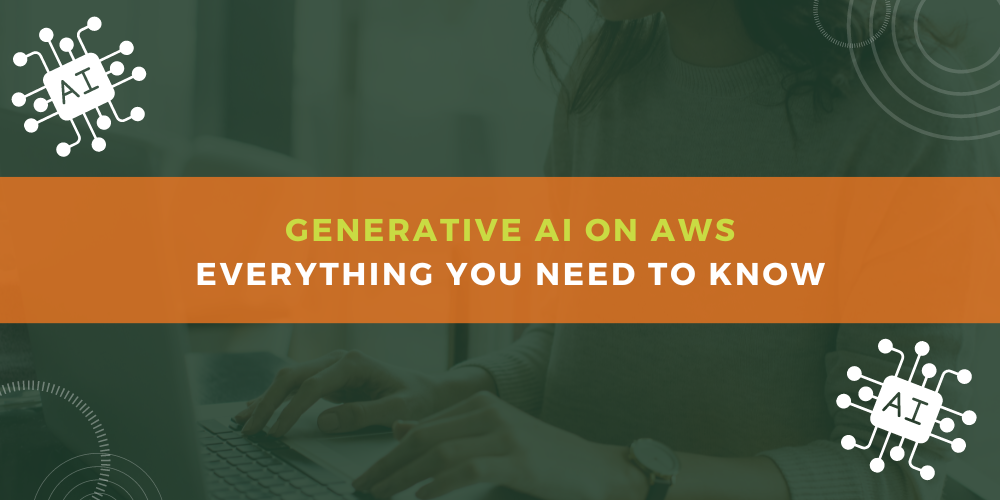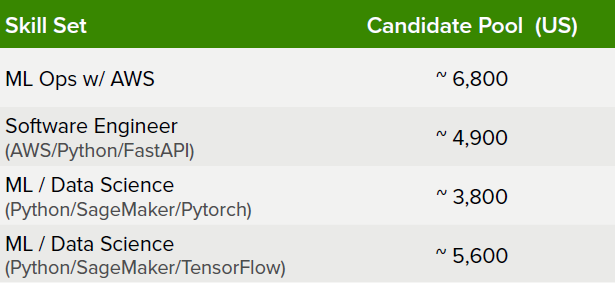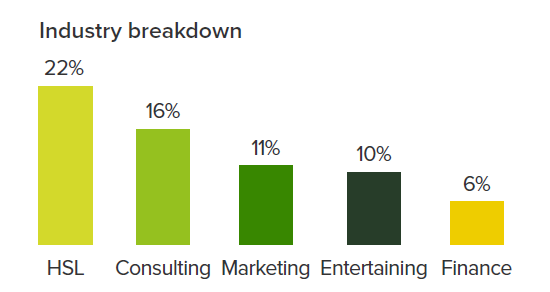Generative AI on AWS: Everything You Need To Know
By Danny Aspinall

Conversations around artificial intelligence (AI) are all the rage right now, particularly in the tech sector, where rapid developments are creating exciting new opportunities for both organizations and tech professionals.
Amongst the hottest topics is generative AI, which promises to streamline business processes and maximize efficiencies while carving out a wide range of new paths for talent to explore. In fact, hundreds of startups are already gaining momentum with their solutions in this space.
And it’s not going anywhere. According to the World Economic Forum, over three-quarters of organizations plan to adopt AI and Machine Learning (ML) in the next five years.
AWS services and capabilities democratize the use of generative AI by making it more accessible to all industries and customer types, meaning now’s the time to get in the know to ensure you can capitalize on everything generative AI has to offer.
As Vice President of Database, Analytics, and Machine Learning at AWS, Swami Sivasubramanian, noted in his AWS NYC Summit 2023 keynote, “generative AI has captured our imaginations [and] this technology has reached its tipping point.”
But what exactly is it all about? How can generative AI benefit organizations across different industries, and what new doors does it open for talent across the AWS community? Let’s explore.
The latest career and hiring insights from the AWS ecosystem.
The Jefferson Frank Careers and Hiring Guide: AWS Edition provides a market-leading insight into trends across the Amazon Web Services community.
What is generative AI?
Generative AI is a type of artificial intelligence…obviously.
More specifically, it’s artificial intelligence capable of creating content and ideas—be that text, images and videos, or prototypes and synthetic datasets.
It’s powered by generative machine learning models often referred to as foundation models (FMs), which are pre-trained on the patterns and structure of vast amounts of input data. A class of these FMs—like GPT models, for example—are commonly called large language models (LLMs) and focus on performing language-based tasks like content creation and information extraction.
Because these FMs are exposed to such a large scale of data and parameters, LLMs are supremely capable of learning advanced concepts and applying them to a wide range of different contexts. Best of all, they’re adaptable to perform domain-specific functions by being highly customizable, meaning organizations can build widely varying applications with FMs using just a small sample of data and compute compared to what’s needed to train a model from the ground up.
What does generative AI mean for businesses?
As we’re sure you’re aware, generative AI applications have already demanded the attention of business leaders with applications such as ChatGPT—and according to Goldman Sachs, this increased adoption of generative AI could accelerate productivity growth by 1.5 percentage points across the next 10 years, leading to a 7% increase in global GDP worth almost $7 trillion. Yep, $7 trillion.
Yet while this sure sounds mighty impressive, what does it actually mean for organizations and their day-to-day operations?
Business uses for generative AI
Some of the fundamental use cases for generative AI on AWS include:
- Content generation: create content and assist with writing and ideation tasks across a range of internal and external resources.
- Personalization: personalize customer experiences across the service cycle with highly relevant content, product recommendations, and more.
- Software development: quickly generate code snippets, comments, and documentation based on natural language inputs.
- Conversational AI: utilize speech-to-tech and language translation, or build natural language-based conversational interfaces like chatbots and virtual assistants that provide human-like interactions.
- Question answering: locate and synthesize information across large bodies of data to answer customer questions using natural language prompts.
- Text summarization: generate concise overviews and receive the main takeaways from long articles, documents, and webpages.
- Search: quickly locate content and information across internal knowledge banks to make data-driven business decisions.
Business benefits of generative AI
With such a huge variety of fundamental uses, generative AI can benefit organizations in a whole lot of different ways, including:
- Enhanced customer experiences: chatbots and virtual assistants are super-effective at successfully automating customer experiences, streamlining self-service processes, and reducing operational costs—the very definition of a win-win! Elsewhere, insightful call analytics and handy agent assistance improve the service offered by your customer service team (remember those living breathing humans?), enabling them to better personalize the customer experience from start to finish.
- Increased employee efficiency: undoubtedly one of the biggest benefits of generative AI is its positive impact on employee productivity. Code generation tools, for example, enable tech teams to source code quickly and accurately, while low-code/no-code applications simplify development and minimize maintenance. Elsewhere, automated report generation speeds up internal reporting and ensures fewer errors, while conversational search features help employees source information efficiently to minimize hurdles.
- Accelerated process optimization: from document processing and fraud detection to supply chain optimization, generative AI solutions can be applied in a wide range of different contexts to improve business operations, reduce costs, and maximize the impact of internal processes.
- Improved creativity and output: generative AI can maximize an organization’s creative output by optimizing content creation and ideation. Whether it’s data-driven sales scripts and design prototypes or engaging marketing copy, generative AI tools save valuable time and resources, while serving as a handy sidekick to multiple teams across an organization.
But of course, this barely scratches the surface of what organizations can achieve with generative AI on AWS. Industries such as Financial Services, Healthcare and Life Sciences (HLS), Automotive and Manufacturing, Media and Entertainment, Telecom, and Energy are well-poised to benefit from higher-level, advanced applications of generative AI sooner than most.
Hiring talent with generative AI skills
While the opportunities presented by generative AI sound super exciting for organizations, its adoption and implementation is unlikely to be quite so straightforward.
As with all emerging and fast-developing technologies, organizations will rapidly be on the hunt for professionals with the skills and expertise they need—but real-world experience with generative AI is extremely limited right now, meaning the talent pool currently lacks qualified professionals. In fact, according to our database, less than 10,000 candidates list generative AI or LLM as something they have experience working on daily, while just 6,800 candidates list MLOps as something they practice day to day.
The table below shows just how small the qualified candidate pool is right now.

As demand grows bigger for talent in this area, this skills gap will only continue to widen—we anticipate the job-to-available candidate gap to be close to four to one by the end of the year.
As a result, employers must be prepared to explore alternative solutions and dip outside the pool of experienced talent, turning to candidates with similar skill sets like:
- Development: Python, React, Typescript, GraphQL
- Frameworks: Pytorch, TensorFlow, FastAPI
- ML Ops: Terraform, Jenkins, Python, Data Dog, Kubernetes, Docker
- AWS Services: Lambda, SageMaker, ECS, EKS, Neptune, DynamoDB
Knowing how to find professionals with not-so-dissimilar skill sets, strong expertise, and the aptitude to pick up new concepts quickly will be integral for organizations looking to get ahead of their competition in this space.
What does generative AI mean for tech professionals?
Generative AI promises to create a sea of new opportunities for professionals in the AWS community.
Don’t believe us? Since the start of 2023, the number of organizations looking to hire talent specifically for their generative AI solutions has increased by over 500%, with over 8,500 openings posted by all types of organizations. In fact, 768 of these vacancies were posted by organizations looking for candidates to help build generative AI products on AWS in July alone.
Organizations in the HLS sector dominated these openings, especially in the startup space—over a fifth (22%) of job postings in July were tied to organizations in or building HLS solutions.

Of these positions, the most in-demand candidates were:
- Full Stack Software Developers
- Machine Learning Engineers
- MLOps Engineers
- Data Scientists
Yet the most exciting part is that this is just the start of what looks set to be an explosive spike in demand for professionals experienced and/or knowledgeable in generative AI solutions, opening the doors to an array of new career opportunities for those qualified candidates, and those with similar skill sets who are keen to upskill and grow.
How to get started with generative AI on AWS
With so much to offer, it’s little wonder both business leaders and professionals across the AWS community are keen to begin experimenting with generative AI—but knowing where to start can be tough.
Not only do business leaders need to understand the fundamentals of what AI can unlock for their organization, but they also need to put the right foundations in place to prepare their businesses for successful AI and ML integration. All the while, AWS professionals need to begin building their skills and expertise in this area to meet the demand for qualified talent.
Luckily, AWS offers invaluable skills training on generative AI for people of all roles and experience levels, empowering professionals, decision-makers, and AWS Partners to better understand use cases and begin leveraging generative AI solutions effectively.
AWS generative AI training for professionals
- Amazon CodeWhisperer – Getting Started: this free course introduces professionals to the fundamentals of the generative AI coding companion, Amazon CodeWhisperer, from how to set it up to how to use it in different programming languages. Aimed at helping developers boost their productivity, learners can work through the course at their own pace while being taught all about CodeWhisper’s exciting capabilities.
- AWS Jam Journey – Build Using Amazon CodeWhisperer: available with an AWS Skill Builder subscription, this interactive, hands-on training provides DevOps professionals with a series of challenges in a secure, sandboxed AWS environment to gain practical experience building with Amazon CodeWhisperer.
- Generative AI Foundations on AWS: designed for tech professionals already familiar with AI modeling, this free course deep dives into conceptual fundamentals, practical advice, and hands-on guidance. It’s available on demand on YouTube and is intended to educate learners on how best to pre-train, fine-tune, and deploy state-of-the-art FMs on AWS.
- Generative AI with Large Language Models: this course is jointly developed by AWS, DeepLearning.AI, and pioneer in ML and education, Andrew Ng. The three-week, hands-on training course is intended to help data scientists and engineers become experts in selecting, training, fine-tuning, and deploying large language models (LLMs) for real-world applications.
- AWS PartnerCast – Building Generative AI on AWS: deep diving into all generative AI services and capabilities on AWS, this course explores how Partners can leverage Amazon Bedrock, Amazon CodeWhisperer, Amazon SageMaker, and more to help their customers.
Generative AI training for businesses and non-technical audiences
- Generative AI for Executives: this handy collection of free videos offers easy-to-understand introductions to core concepts, and is intended to help C-Suite executives comprehend how generative AI can help overcome business challenges and drive growth.
- Generative AI Innovation Center: this program pairs organizations looking for guidance on generative AI with AWS strategy experts who have deep AI/ML experience. Through education, workshops, engagement, and an execution roadmap, the Generative AI Innovation Center offers organizations specialist-led, hands-on assistance to identify achievable use cases for generative AI based on your main business priorities.
The generative AI options available through AWS unlock a whole new world of exciting possibilities for both organizations and professionals across the AWS community, and as AI/ML solutions continue to evolve, its impressive capabilities will only continue to grow. That means whether you’re an AWS professional looking to get ahead in your career or a business leader searching for new innovations and optimizations, it pays dividends to begin investing your time, effort, and resources into generative AI today.
Looking to expand your team of AWS specialists?
Whether you’re on the hunt for a contractor or permanent hire, find the tech talent you need by searching our extensive database of candidates today.
Search nowInformations sur le marché AWS
les postes AWS par localisation
- Emplois AWS en Australie
- Emplois AWS en Autriche
- Emplois AWS en Belgique
- Emplois AWS en Bulgarie
- Emplois AWS en République Tchèque
- Emplois AWS au Danemark
- Emplois AWS en Finlande
- Emplois AWS en Allemagne
- Emplois AWS en Suisse
- Emplois AWS en Hongrie
- Emplois AWS en Irlande
- Emplois AWS en Italie
- Emplois AWS au Luxembourg
- Emplois AWS aux Pays-Bas
- Emplois AWS en Norvège
- Emplois AWS en Pologne
- Emplois AWS en Roumanie
- Emplois AWS en Slovaquie
- Emplois AWS en Afrique du Sud
- Emplois AWS en Suède
- Emplois AWS au Royaume-Uni
- Emplois AWS aux États-Unis
les postes Aws par roles
- Offres d'emploi d’Administrateur AWS
- Offres d'emploi d’Analyste AWS
- Offres d'emploi d’Architecte AWS
- Offres d'emploi d'Associé AWS
- Offres d'emploi de Consultant AWS
- Offres d'emploi de Développeur AWS
- Offres d'emploi de DévOps AWS
- Offres d'emploi de Directeur AWS
- Offres d'emploi d’Ingénieur AWS
- Offres d'emploi de Cadre AWS
- Offres d'emploi de Responsable AWS
- Offres d'emploi Plateforme AWS
- Offres d'emploi dans les ventes AWS
- Offres d'emploi de Spécialistes AWS
- Offres d'emploi OpsSys AWS
- Offres d'emploi de Technicien AWS
- Autres offres d'emploi AWS